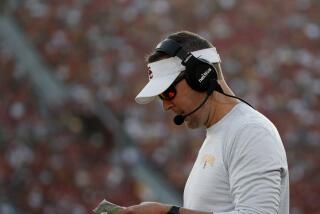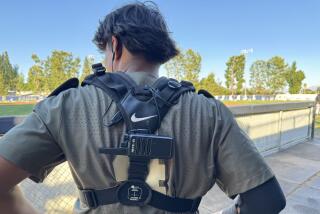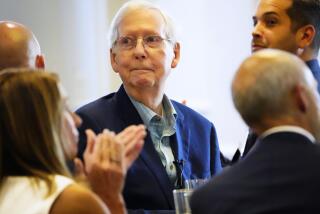Concussion report makes an impact
By the time Matt Inman and his teammates shuffled into the computer lab at Servite High last week, they had already seen the news.
The NFL had issued a warning to its players that repeated concussions could lead to memory loss, personality changes, depression and early onset of dementia.
The unusually strong wording — part of a growing focus on concussions throughout the sports world — made an impact on the 17-year-old Inman, an all-county linebacker for the Friars.
“I don’t remember it being like this before,” he said. “It’s getting a lot more serious.”
And the risks aren’t limited to professionals.
Servite summoned its team to campus last week for a pilot program with UC Irvine. The athletes underwent baseline testing that measured their concentration and memory, setting a number that can be used later this season to determine if they are suffering from concussion.
The players spent their lunch hour sitting at computers, watching and reacting as words and shapes flashed across the screens.
“There’s been no real standardized treatment before this — some players stay on the field, some players come off,” said David Franklin, a neuropsychologist and assistant clinical professor at UC Irvine. “This is another safeguard to help.”
An estimated 400,000 high school athletes suffered concussions from 2005 through 2008, according to the House Education and Labor Committee, which held a hearing to address the issue in May.
“Before two or three years ago, the awareness was pretty low,” said Dr. Gerard Gioia, chief of pediatric neuropsychology at the Children’s National Medical Center in Washington. “Now we’re starting to crank things up.”
Recent studies suggest that because young brains are still dynamic and changing, teenagers suffer greater harm from concussions than adults do, said Gioia, who spoke at this spring’s congressional hearing.
The list of risky sports includes football, hockey, soccer and water polo.
At Servite in Anaheim, head trainer Chaz Kekipi recalled playing high school football during an era when concussions often went overlooked.
“You’d get some head injuries and it was like, oh, I got my bell rung,” he said.
But when treating athletes became his job, the stocky former lineman started paying more attention and found there weren’t many diagnostic tools available to trainers.
Researchers are still working to understand brain injuries and their relationship to pain, behavior and cognitive functions. Much remains unknown about recovery — obvious symptoms may disappear while subtler ones linger.
“It’s very difficult to judge how much damage is done,” Kekipi said. “And it’s a very subjective way of returning kids to play when their headache is gone.”
Adding to the problem, athletes aren’t always honest with coaches, doctors and parents about how they feel.
“You ask them, ‘Are you having a headache, are you having dizziness?’ and they say they’re fine,” said David Kruse, medical director of the Orthopaedic and Sports Medicine Center at UC Irvine, who has worked with Servite athletes in the past.
“They’re focused on when they can get back to sports, when they can help their teammates out again, and that’s fine,” he said. “But that’s where our job comes in.”
And that is why last week’s baseline testing at Servite could help.
At one point during the 25-minute evaluation, lineman Wyatt Baker watched a series of words flash across the computer screen. Then, he was given a list and asked to identify the words that had appeared previously.
“It was a lot of memory stuff, remembering shapes, letters, words,” Baker said. “At the start it was easy; it got more and more difficult as the test went on.”
Other portions of the test gauged reaction times and motor skills.
If Baker appears to suffer a concussion this season, Kekipi can test him again and compare scores. It’s not the only consideration — doctors might also look at balance and mood changes, which cannot be measured by computer — but it offers a clue as to how much the brain has been injured.
And it helps officials decide when an athlete can return to the field.
“If you have that baseline, then you have a benchmark,” said Kevin Guskiewicz, director of the Matthew Gfeller Sports-Related Traumatic Brain Injury Research Center at the University of North Carolina. “It helps eliminate some of the guesswork.”
That can be especially significant because athletes who return too quickly, suffering one concussion on top of another, risk greater injury.
Left undiagnosed, multiple concussions may cause long-term brain damage.
So the UC Irvine professors believe the pilot program at Servite is important. Baseline testing is going on at various schools around California and they would like to see the technology used everywhere.
Before the evaluation began, Franklin gathered the players and reminded them to try their hardest. Kekipi was there too.
“This is a way to protect the kids from coaches and overeager parents and from themselves,” the trainer said. “To have a neurocognitive program, yeah, I do rest easier knowing my kids are safe.”
Inside the computer lab with its rows of screens on long tables and colorful banners from various colleges, a proctor watched to make sure everyone worked intently.
Having seen the NFL report on television, linebacker Inman said he appreciated the seriousness of the matter, though he added: “I can’t really see myself missing a game because of a headache.”
With baseline testing, he might not have a choice.
twitter.com/LATimesWharton
More to Read
Sign up for Essential California
The most important California stories and recommendations in your inbox every morning.
You may occasionally receive promotional content from the Los Angeles Times.











